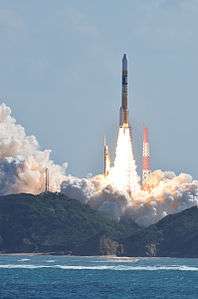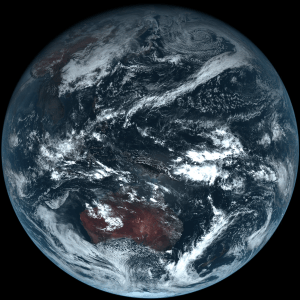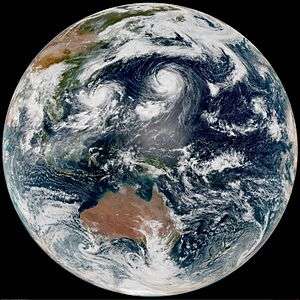Himawari 8
| Mission type | Weather satellite |
|---|---|
| Operator | JMA |
| COSPAR ID | 2014-060A |
| SATCAT no. | 40267 |
| Mission duration | 8 years (planned) |
| Spacecraft properties | |
| Bus | DS-2000 |
| Manufacturer | Mitsubishi Electric |
| Launch mass | 3500 kg |
| Dry mass | 1300 kg |
| Power | 2.6 kilowatts from solar array |
| Start of mission | |
| Launch date | 7 October 2014, 05:16 UTC |
| Rocket | H-IIA 202 |
| Launch site | Tanegashima LA-Y1 |
| Contractor | Mitsubishi Heavy Industries |
| Entered service | 7 July 2015, 02:00 UTC[1] |
| Orbital parameters | |
| Reference system | Geocentric |
| Regime | Geostationary |
| Longitude | 140.7° East |
| Perigee | 35,791 km (22,239 mi)[2] |
| Apogee | 35,795 km (22,242 mi)[2] |
| Inclination | 0.03 degrees[2] |
| Period | 1436.13 minutes[2] |
| Epoch | 22 January 2015, 22:13:28 UTC[2] |
Himawari 8 (ひまわり8号) is a Japanese weather satellite, the 8th of the Himawari geostationary weather satellites operated by the Japan Meteorological Agency. The spacecraft was constructed by Mitsubishi Electric with assistance from Boeing, and is the first of two similar satellites to be based on the DS-2000 satellite bus.[3] Himawari 8 entered operational service on 7 July 2015 and is the successor to MTSAT-2 (Himawari 7) which was launched in 2006.
Launch
Himawari 8 was launched atop a H-IIA rocket flying from the Yoshinobu Launch Complex Pad 1 at the Tanegashima Space Center.[4] The launch occurred at 05:16 UTC on 7 October 2014 and reached its operational geostationary orbit in October 2014, at 140.7 degrees East.[5]
Himawari 9, which is identical to Himawari 8, was launched on 2 November 2016 and placed in a stand-by orbit until 2022, when it is planned to succeed Himawari 8.
Design
The DS2000 satellite bus has a lifespan of 15 years, however the expected operational lifespan of Himawari 8 is expected to be limited by its instruments which are only designed for 8 years of service. At launch, the mass of the satellite was about 3,500 kilograms (7,700 lb). Power is supplied by a single gallium arsenide solar panel, which provides up to 2.6 kilowatts of power.[6]
Instruments
The primary instrument aboard Himawari 8, the Advanced Himawari Imager (AHI), is a 16 channel multispectral imager to capture visible light and infrared images of the Asia-Pacific region.[6] The instrument was designed and built by Exelis Geospatial Systems (now Harris Space & Intelligence Systems) and has similar spectral and spatial characteristics to the Advanced Baseline Imager (ABI) used in the American GOES-16, -17, -T, and -U satellites. The AHI can produce images with a resolution down to 500m and can provide full disk observations every 10 mins and images of Japan every 2.5 minutes.[6] The Australian Bureau of Meteorology CEO Dr Rob Vertessy stated that Himawari 8 "generates about 50 times more data than the previous satellite".[7]
Data recorded from the Japanese Himawari 8 will be made freely available for use by meteorological agencies in other countries.[7]
Gallery
 Liftoff of the H-IIA rocket carrying Himawari 8 on October 7, 2014
Liftoff of the H-IIA rocket carrying Himawari 8 on October 7, 2014 The first true-color PNG image from Himawari 8 on January 25, 2015
The first true-color PNG image from Himawari 8 on January 25, 2015 Example of a Rayleigh-corrected, true-color full disk image created from the AHI sensor.
Example of a Rayleigh-corrected, true-color full disk image created from the AHI sensor.
References
- ↑ "静止気象衛星「ひまわり8号」の運用開始日について" (in Japanese). Japan Meteorological Agency. Retrieved 27 May 2015.
- 1 2 3 4 5 Peat, Chris (22 January 2015). "HIMAWARI 8 - Orbit". Heavens-Above. Retrieved 25 January 2015.
- ↑ Graham, William. "Japan lofts Himawari 8 weather satellite via H-IIA rocket". NASASpaceflight.com. Retrieved 7 October 2014.
- ↑ Clark, Stephen. "H-2A rocket boosts Japanese weather satellite into orbit". Spaceflight Now. Retrieved 7 October 2014.
- ↑ "JMA/MSC: Himawari-8/9". Japan Meteorological Agency. Retrieved 7 October 2014.
- 1 2 3 "New geostationary meteorological satellites — Himawari-8/9 —" (PDF). Japan Meteorological Agency. Retrieved 7 October 2014.
- 1 2 "Spectacular new era in satellite meteorology unveiled". Australian Bureau of Meteorology. Commonwealth of Australia. 30 September 2015. Retrieved 30 September 2015.
External links

- Meteorological Satellite Center of JMA
- JMA Satellite Imagery, providing infrared, vapor and true-color Himawari 8 imageries every 30 minutes
- Himawari-8 Real-time Web from NICT, providing full-disc pictures of true color and all 16 bands every 10 minutes
- RealEarth™ including imageries from all 16 bands of Himawari 8
- Himawari-8 - Third-Generation Weather Satellite from Digital Typhoon
- Himawari 8 3D model from Asahi Shinbun